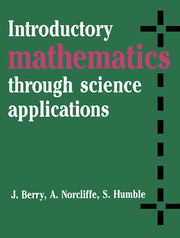Book contents
- Frontmatter
- Contents
- Preface
- 1 Basic functions
- 2 Functions for science 1: the exponential function
- 3 Functions for science 2: trigonometric functions
- 4 Functions for science 3: inverse functions
- 5 Other functions of science
- 6 Differentiation 1: rates of change
- 7 Differentiation 2: stationary points
- 8 Differentiation 3: approximation of functions
- 9 Integration 1: introduction and standard forms
- 10 Integration 2: techniques of integration
- 11 Integration 3: further techniques
- 12 First-order ordinary differential equations
- 13 Second-order ordinary differential equations
- 14 Statistics 1: frequency distributions and associated measures
- 15 Statistics 2: probability and probability distributions
- 16 Statistics 3: sampling, sampling distributions and hypothesis testing
- 17 Partial differentiation 1: introduction
- 18 Partial differentiation 2: stationary points
- Answers to the exercises
- Index
10 - Integration 2: techniques of integration
Published online by Cambridge University Press: 05 June 2012
- Frontmatter
- Contents
- Preface
- 1 Basic functions
- 2 Functions for science 1: the exponential function
- 3 Functions for science 2: trigonometric functions
- 4 Functions for science 3: inverse functions
- 5 Other functions of science
- 6 Differentiation 1: rates of change
- 7 Differentiation 2: stationary points
- 8 Differentiation 3: approximation of functions
- 9 Integration 1: introduction and standard forms
- 10 Integration 2: techniques of integration
- 11 Integration 3: further techniques
- 12 First-order ordinary differential equations
- 13 Second-order ordinary differential equations
- 14 Statistics 1: frequency distributions and associated measures
- 15 Statistics 2: probability and probability distributions
- 16 Statistics 3: sampling, sampling distributions and hypothesis testing
- 17 Partial differentiation 1: introduction
- 18 Partial differentiation 2: stationary points
- Answers to the exercises
- Index
Summary
In Chapter 9 we defined what we meant by a definite and an indefinite integral and used the Fundamental Theorem of Calculus to obtain the integrals of basic functions. We also introduced numerical methods of integration because there are many functions for which analytic integrals cannot be found.
In this chapter we concentrate on techniques of integration that can be used to reduce complicated looking integrands to a basic form that can be evaluated analytically. We should stress at the outset that there are no standard rules of integration that will always work, unlike the standard rules for differentiation. There is a certain amount of guesswork and experience involved with the evaluation of integrals. In 10.2 we introduce various substitutions that often help and in 10.4 we consider a method for tackling integrals of products of functions.
Scientific context
Example 1: the centre of mass of a lamina. One of the important properties of a body is the position of its centre of mass; this is the point at which all the mass can be thought to act when the body is moving in a straight line. For such translational motion the body can be modelled as a particle with its mass concentrated at this point. Finding the centre of mass is thus important and makes use of the technique of integration. Without any loss of generality let us consider how integration is used in finding the position of the centre of mass of a uniform lamina; this is often called the centroid.
- Type
- Chapter
- Information
- Introductory Mathematics through Science Applications , pp. 259 - 285Publisher: Cambridge University PressPrint publication year: 1989



